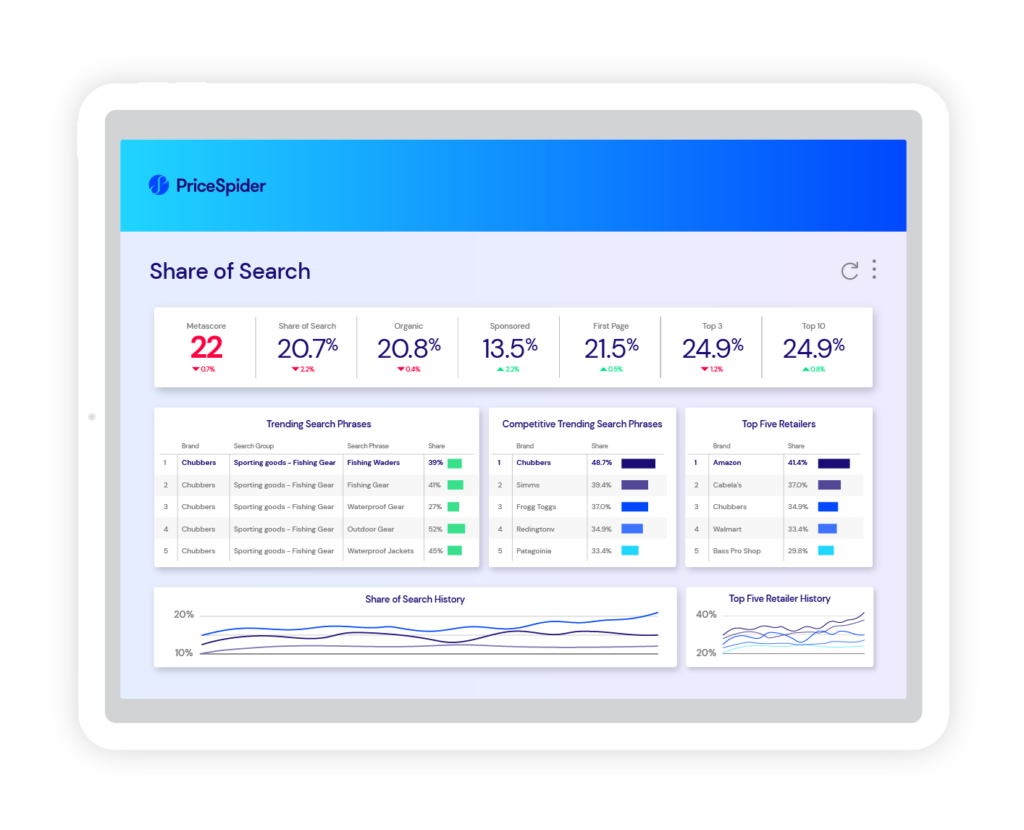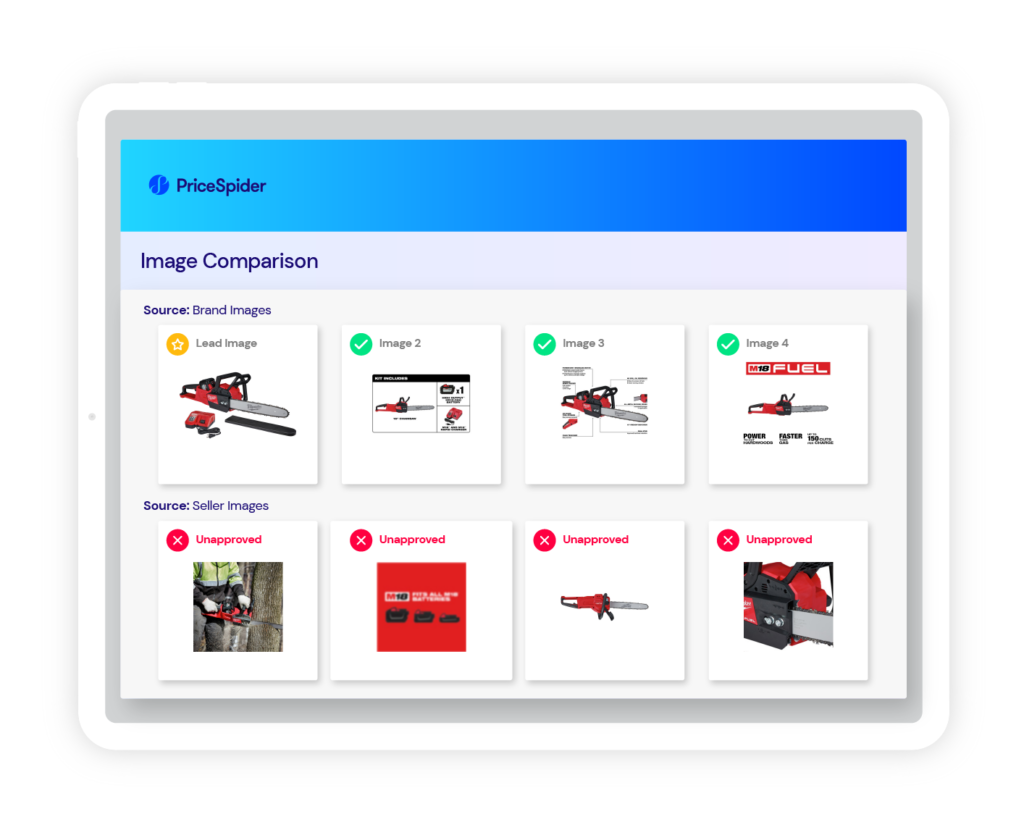You know the old TV troupe: the bad guy disguises himself as a good guy, they get into a tussle, and the rest of our heroes are left to determine who’s the real one.
“Shoot him, he’s the imposter!”
“No, shoot him, he’s the imposter!”
Usually they’re posed a trick question that only the real McCoy would answer correctly. “And I would have gotten away with it too if it weren’t for you meddling kids!”
Similarly, there’s no shortage of software and tools that claim to be digital shelf analytics solutions but are really imposters. Take a closer look and you’ll see that many of them have little to do with analyzing and improving your position on the digital shelf.
You’re looking for tools to help your brand win more sales from online marketplaces and retailers. But some vendors don’t offer the software features and data insights you need to do that.
In this guide, we help you tear the disguise off the imposters and narrow your options with a series of questions you should be asking. Some of these questions eliminate options right off the bat. Others help you spot the differences between top contenders. By the time you finish, you’ll have the insights you need to make an informed decision about your digital shelf analytics solution.
For starters, let’s make sure we’re on the same page about what this category of software even means.
What is a digital shelf analytics solution?
A digital shelf analytics solution is a tool that helps you monitor, evaluate, and optimize your position on the digital shelf. It crawls retail websites and collects data about your product pages and how consumers interact with them across the entire digital shelf. It won’t necessarily have workflows for you to modify pages or interact with retailers, but it should provide actionable insights with clear next steps.
Some software programs use the label “digital shelf analytics solution,” but when you look at what they actually do, it becomes clear that they’re only distantly related to the digital shelf or that their analytics capabilities are extremely limited. This isn’t sales forecasting software. It’s not for distributing product page content. It’s not just about measuring customer sentiments. And while monitoring your price and pricing policy is certainly important, that’s not the main purpose of a digital shelf analytics solution.
A digital shelf analytics solution lets you compare your performance across retailers and home in on individual sales channels. When there are critical differences between product pages, it illuminates them in useful ways. And ideally, you should be able to examine your competitors’ pages just as thoroughly.
Digital shelf analytics (DSA) is an ongoing process. A digital shelf analytics solution is the tool that facilitates this process.
Now let’s look at how to choose between programs and platforms that present themselves as DSA solutions.
What does it measure?
“The digital shelf” is pretty broad. It includes every digital touchpoint consumers use to discover, learn about, compare, and purchase products. Digital shelf analytics typically focuses on the metrics that relate to your product pages and how your brand appears on various ecommerce websites.
While things like social media may technically be part of the digital shelf, analyzing your performance on various marketing channels doesn’t tell you much about how you’re doing in the places where your audience goes to buy your products.
Given the breadth of things you could analyze on the digital shelf, the first thing to consider when comparing solutions is what do you want to analyze? What are the digital shelf metrics that matter to your brand? With the right DSA solution, you could:
- Evaluate your performance in retailer search engines
- Find and eliminate product page variations
- Track stock availability
- Examine trends in your ratings and reviews
- Identify minimum advertised pricing (MAP) violations
Share of search is an especially valuable metric you can only see with a specialized DSA solution. This lets you track how your target terms and phrases rank on a specific retailer’s website, and whether your placement is for paid or organic results. You can see which competitors are showing up alongside your brand and investigate which keywords they’re paying for.

Content compliance is also crucial. You want customers to have the same experience with your brand everywhere they find you and for your product pages to perform their best. Over time, product page variations reduce sales, confuse and mislead customers, and hurt your brand integrity. Content compliance monitoring helps you spot pages that don’t align with your brand guidelines so that you can either make changes to the product information management (PIM) system or contact your representative.
Not all content compliance monitoring solutions are the same though. Many only crawl the text on your product pages — but images and video are integral pieces of content, too. Outdated images can mislead customers and inhibit performance just as much as outdated copy.

Most vendors focus on just one of the essential digital shelf metrics, leaving you with an incomplete solution, forcing you to piecemeal together multiple tools. If each capability is important to you (which they should be), you’re better off looking for platforms that offer them all. That helps you eliminate options that present themselves as being more than they actually are.
PriceSpider’s digital shelf analytics solution, Brand Monitor, equips you to track and analyze all these metrics and more.
Can the solution collect data from your sellers?
Imagine buying a DSA solution to track your performance across sales channels, only to learn that it can’t pull data from all of your distributors. Most vendors promise to track your product everywhere it appears on the web, but with limitations. They can only crawl a finite number of online retailers and marketplaces. Obviously, the more they can crawl, the better, but the key is to make sure they can track your online retailers and the marketplaces your sellers actually use.
This is particularly important when you sell on niche websites, which may be well-known within your unique audience and category, but more obscure in relation to ecommerce as a whole.
Brand Monitor crawls more than 2,000 online retailers and over 20 marketplaces, including every major retailer in the world, and the list is always expanding. Additionally, if you sell on a website we don’t already have the ability to pull data from, we’ll build the integration at your request.
How often does the solution gather data?
If it takes you days to spot a critical error on a product page, a pricing violation, or a substantial drop in ratings, the delay will cost you money and hurt your brand. You might be misleading customers, forcing sellers to engage in price wars, or allowing a product defect or distribution issue to persist. Maybe your product has been out of stock for two days, and you’ve been spending ad dollars to drive people to a page they can’t buy from.
In ecommerce, brands need quick reflexes to stay competitive. But that can only happen if your digital tools refresh data frequently. Some vendors claim to offer real-time tracking capabilities, but it’s essential that you investigate what they really mean by this.
Brand Monitor gives you real-time insights into the digital shelf using our proprietary “crawling” technology. Our software visits every page your SKU appears on just like a real person. The moment a product’s stock availability changes or the price drops below your minimum, you’ll see it in the dashboard. You can even set alerts to get notified anytime there’s something you need to act on.
With real-time data, you can turn off ad spend the moment your product goes out of stock. Or similarly, you can turn on ad spend for a competitor’s branded keywords as soon as they go out of stock. If your digital shelf analytics solution only updates stock availability daily (or worse, on specific days of the week), you’re going to miss these windows of opportunity — or more frustratingly, it may look like the window is open long after the product is back in stock.
How can you explore the data?
Aggregate data is helpful. But in ecommerce, it’s also valuable to see how data points change over time or a specific date range. For metrics such as ratings, it’s critical to identify a sudden drop in ratings to zero in on what went wrong. If you only look at your average ratings for the last five years, you won’t even notice when your weekly or monthly average comes crashing down.
Seeing stock availability over time could also help you detect larger issues in your supply chain (or a competitor’s).
Keeping an eye on your Share of Search over time can show you the effect of a marketing campaign, changes you made to your product page content, or a sudden boost in ratings.
Of course, this data is only useful if the software presents it in simple, intuitive ways. Advanced doesn’t have to mean complex. A quality digital shelf analytics solution doesn’t just gather data, it makes that data easy to find and manipulate.
Do major brands trust this vendor?
Obviously, just because a huge brand uses a tool, doesn’t mean it’s a quality tool. But, major brands have a lot more to lose than most. They usually have the internal resources and expertise to properly vet the solutions they adopt. It’s definitely worth knowing if some of your options are more popular with leading brands. Especially if they’re used by brands you’d like to emulate.
Some software vendors build excellent tools, but they simply haven’t had much adoption yet. That’s fine. You wouldn’t necessarily want to rule out an option because it was new, but tools that have been used on a global scale by notable brands are a safer bet. Operating on a larger scale and with higher stakes forces vendors to heavily invest in infrastructure such as technical support and customer service. A smaller, younger vendor may not be able to give every customer the attention you deserve.
Want to be the best? Level the playing field by using the tools they rely on for a competitive advantage.
Brand Monitor was built by PriceSpider, and for more than 20 years, we’ve been producing specialized ecommerce software based on advanced crawling capabilities. More than 2,000 brands trust our tools and the team behind them, including many of the world’s leading brands, such as P&G, Samsung, Hershey, Wrigley, LG, Nintendo, and Adidas.

See what it actually looks like
You’re probably not going to be in your digital shelf analytics solution 24/7, but when you do use it, don’t be miserable. If getting the data you need feels like pulling teeth, it doesn’t matter whether the tool technically has the capabilities you need. The solution you choose should feel convenient and intuitive so those who need it actually use it.
With technical ecommerce software, a demo is usually the best way to see if it’ll work for you. There’s no commitment, and you can watch how an expert uses it. You can ask questions and see examples that are specific to your brand, and you’re not stuck figuring it all out on your own. When vendors make big promises in their marketing, a demo is the perfect opportunity to put their claims to the test.
If a product expert has to jump through multiple tabs, menus, and filters just to answer simple questions or pull basic data, it’s worth asking: how often will you need to perform that same sequence of actions? How many people will need to learn how to do this? Can they? A demo shows you the nuts and bolts of the software to gauge whether it will work for your brand.
Schedule a demo of the premier DSA solution
No digital shelf analytics solution on the market can match the breadth and depth of Brand Monitor. Built on our proprietary crawling technology, Brand Monitor gives you the visibility you need to see how you stack up against the competition, analyze how customers experience your brand across the web, and identify problems in real-time.
Schedule a demo today. We’ll show you how Brand Monitor helps you analyze and improve your position on the shelf.

